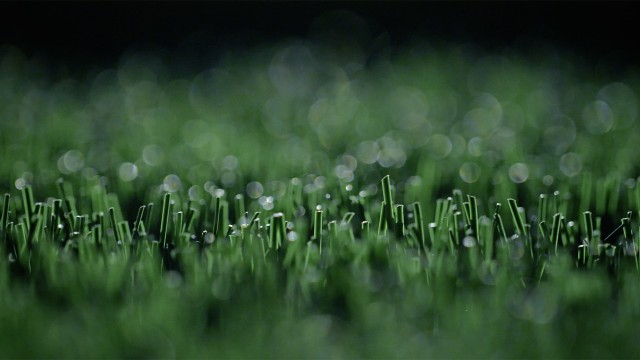An artificial turf surface will greatly reduce the amount of necessary maintenance, but it won’t completely eliminate the need to regularly care for your field. Dealing with season changes is one of the biggest challenges facing field managers and owners. When spring arrives, the sooner you can tend to your field, the sooner it will be ready for play. How to start? Here’s our guide to getting your field ready for spring:
Step 1. Snow Removal
The components that make up your FieldTurf system don’t freeze, although the moisture that seeps into the infill does. This allows you to plow the field without removing a significant amount of infill. The ideal climactic conditions for plowing are always below freezing — that is, colder than 32 degrees Fahrenheit and 0 degrees Celsius. To be safe, 25 degrees F and minus -5 degrees C should be your threshold. It’s a good idea to keep pace with snowfall and regularly plow the field, so the snow doesn’t pile up.
Once snow is removed, and if there is only a small crust of ice remaining on the top of the surface, rotating tines on the FieldTurf GroomRight can break up the ice. In some cases, a little extra weight might be required to get the job done, which is when the rotary brush (with nylon bristles only) on the Lay-Mor or similar sweeping machine will come in handy. As always, proceed with caution using this machine, so as not to disturb too much of the infill. Once the snow and ice are gone, you may move on to the next step.

Step 2. Walk Your Field:
A key step to maintenance is scheduling regular walk-throughs – by doing so, you can expect your field to provide long-lasting performance for its lifespan. A full-field walk-through will indicate if the field needs brushing, raking, aerating, or sweeping of leaves, paper, trash and other debris. If the field needs sweeping, do that before using any type of grooming equipment.
While on a walk-through, also keep your eyes open for minor repairs needed (the soccer penalty spot or hash marks for example) Tending to those maintenance tasks may require the assistance of your FieldTurf Maintenance Expert. Attempting to keep the field free of food, chewing gum, sunflower seeds, glass, cigarettes, fireworks, unauthorized vehicles, and any sharp objects that risk damage to the surface or injury to players will significantly reduce time spent on maintenance efforts.
It’s important to walk your field in the spring to remove large debris and flag any issues that may have arisen due to the winter months
Once you’ve walked your field, you may move on to the next step.

Step 3. BARS:
Now that you examined your surface it’s time to get it back in shape. We have four basic maintenance operations, for which we’ve coined the acronym BARS: Brushing, Aerating, Raking, Sweeping. If you adhere to a consistent maintenance schedule following the BARS guidelines, you can expect your field to provide long-lasting performance for its lifespan.
Here is a summary of each step in the BARS process:
Brushing: This rejuvenates matted fibers and levels the top portion of the infill. Recommended action: Every 4 to 6 weeks.
Aerating: Rotating tines are designed to penetrate and loosen the infill to avoid minor compaction. Recommended action: Maximum 3 times per year (beginning in the second year, if needed).
Raking: This step prevents fibers from becoming matted and keeps the top layer of Infill loose. Recommended action: Every 4 to 6 weeks.
Sweeping: A clean field helps ensure that foreign material or debris does not get into the infill. Sweeping the field must be done immediately following any other maintenance procedure (Ideally, of course, before and after) to prevent foreign material from settling into the infill before usage. Recommended action: As needed.
Remember that infill displacement is normal, resulting in both high spots and low spots throughout and around the field. In high spots, simply brush out the infill until it’s evenly distributed. In low-infill areas, add more infill and then distribute it by brushing. Proper infill depth allows for ¾-of-an-inch of fiber to be exposed. A handheld rake, handheld infill scooper and infill depth gauge are essential tools when maintaining infill levels.
We offer a complete line of custom equipment engineered to facilitate all of the maintenance requirements established by BARS. All equipment and vehicles used on FieldTurf fields must be equipped with turf tires.
Contact your Service Expert at maintenance@fieldturf.com to learn more on FieldTurf equipment.
Before operating any machinery on your surface, be sure to reference the necessary precautions stated in the FieldTurf Maintenance Guideline. If you are unsure whether your current maintenance equipment will work on your field, please contact your FieldTurf customer service representative.

FieldTurf FieldCare Program:
The FieldTurf FieldCare program, will not only keep your field looking and playing its best, but can extend the lifespan of your field by many years. Trust our FieldCare experts to take control of your field and ensure the proper inspections and regular maintenance are performed. You can rest easy.
Our FieldCare Team is specially trained to analyze and maintain artificial turf surfaces. Consult with your FieldCare Service Manager to find the FieldCare program that’s right for you/ Let’s get started: fieldcare@fieldturf.com
For questions regarding field maintenance, we’re here to help. Reach out to your service experts at maintenance@fieldturf.com


